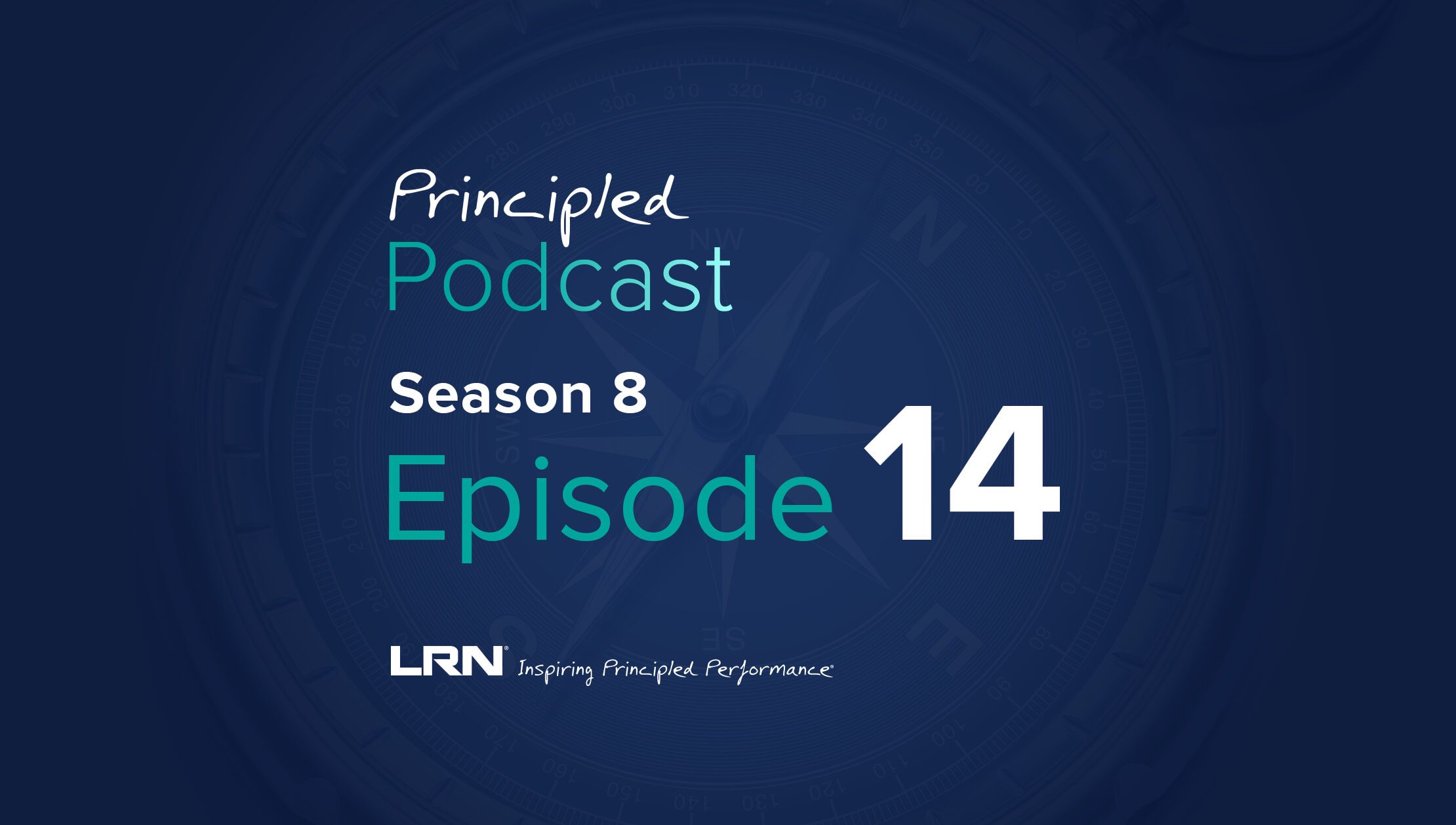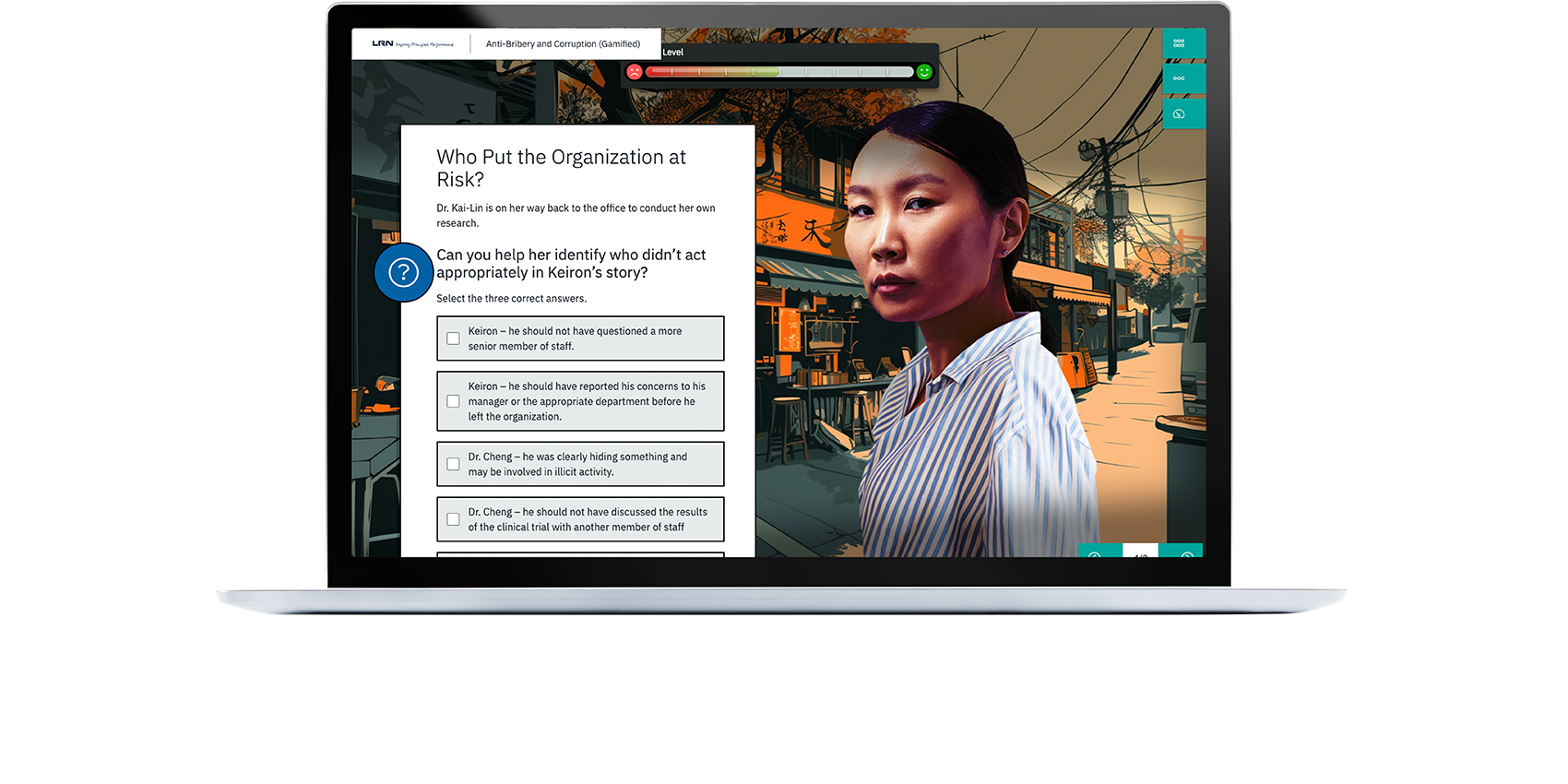What you'll learn on this podcast episode
It’s no secret that writing a code of conduct doesn’t change your company culture overnight. It’s important to develop training that educates your employees on what’s included in your code, and how those elements apply to their day-to-day work. But how can you do that in a way that makes your code dynamic and accessible? On this Principled Podcast episode, host Jim Walton talks to Chris Dunstan, the Chief Compliance Officer & Group General Counsel at SPX Flow, about how the company tailored its code of conduct training to better reflect the responsibilities of employees, while also keeping the material interactive and connected to its evolved brand. The training has received enthusiastic industry recognition, winning gold at this year’s Brandon Hall Awards for Best Advance in Compliance Training. More importantly, the training has reached a record-high completion rate across SPX Flow’s global offices.
Where to stream
Be sure to subscribe to the Principled Podcast wherever you get your podcasts.
Guest: Chris Dunstan
Chris Dunstan is a versatile legal leader with an aptitude for legal operations, strategy, and optimizing the intersection of business and the law. He is the Chief Compliance Officer & Group General Counsel at SPX FLOW, a diversified manufacturer of industrial equipment with operations in more than 30 countries. In this role, he manages the global litigation docket and compliance program and leads a team responsible for all commercial legal activities for multiple product portfolios. Prior to joining SPX FLOW, Chris was the general counsel at Lucifer Lighting and spent more than a decade working as the senior litigation counsel for Ericsson.
Chris has spent much of his career helping both public and private companies navigate complex legal issues in dynamic, highly regulated industries such as telecommunications, consumer products, and industrial equipment manufacturing. He always strives to share his deep functional expertise in high-stakes litigation, IP protection and licensing, foreign and domestic regulatory compliance (FCPA / UK Bribery Act / GDPR / CCPA), and commercial transactions.
Host: Jim Walton
Jim Walton is a member of LRN’s Ethics & Compliance Advisory Services Team – with over 25 years of professional experience in corporate, institutional and government settings, spanning the fields of ethics and compliance; environment, health and safety; and energy management.
Since 2002, Jim has been passionately dedicated to corporate ethics and compliance – designing, developing, implementing and enhancing constantly-evolving, comprehensive, best-in-class, global ethics and compliance programs. Jim has extensive experience in writing, producing and communicating codes of conduct and corporate policies; designing, managing and implementing ethics & compliance risk assessments; implementing anti-compliance and bribery initiatives; conducting third-party due diligence reviews; and helping managers at all levels become better ethical leaders.
Jim is a Certified Compliance and Ethics Professional.
Principled Podcast transcription
Intro: Welcome to the Principled Podcast, brought to you by LRN. The Principled Podcast brings together the collective wisdom on ethics, business and compliance, transformative stories of leadership, and inspiring workplace culture. Listen in to discover valuable strategies from our community of business leaders and workplace change makers.
Jim Walton: A well-crafted code of conduct acts as a blueprint for ethical culture, defining the values and behaviors that guide people to do the right thing in your organization. It's no secret, though, that launching an effective code of conduct doesn't change your company culture overnight. It's important to educate your employees on the key concepts from your code, and how those elements apply to their day-to-day work, but how can you do that in a way that makes your code relevant, dynamic, and accessible? Hello, and welcome to another episode of LRN's Principled Podcast. I'm your host, Jim Walton, senior ethics and compliance advisor at LRN. Today I'm joined by Chris Dunstan, the chief compliance officer and group general counsel at SPX FLOW. We're going to be talking about how SPX FLOW tailored its code of conduct training to better reflect the actual experiences of employees while also keeping the material interactive and connected to SPX FLOW's evolved business and brand. The course has received enthusiastic industry recognition, winning gold at this year's Brandon Hall Awards for best advance in compliance training. More importantly, the training has reached a record high completion rate across SPX FLOW's global operations.
Chris, thanks for coming on the Principled Podcast. I know there are lessons for others here, and I'm excited for you to share your story.
Chris Dunstan: Yes, thanks for having me, Jim. We've had a long and successful relationship with LRN over the years, and I'm really excited to have the opportunity to tell folks about this project that we've worked on very successfully together.
Jim Walton: I'm so glad to hear it. For those who aren't familiar with SPX FLOW, let's start at the beginning. Can you tell our listeners a little bit about your business, and what your expectations were for your new code of conduct course?
Chris Dunstan: Sure. So SPX FLOW is a global diversified industrial manufacturing company. We have about 4,500 employees, and operations in 30 countries across the globe. So when we started this project with LRN, we wanted to have a tailored training to address specific scenarios that our employees face on a day-to-day basis. Before this, our annual compliance training was LRN's modular code of conduct, which while having a diverse set of training modules, wasn't branded or necessarily tailored to our unique business operations as a industrial manufacturing company, so we wanted something that was tailored to our specific business. We also wanted something that could be adaptable in the future. So going through this process is a big deal to the business. There's a significant cost associated with it. Although we found LRN to be very cost effective, there's still an investment that we have to make. And so you want something that can be adapted to use in the future so that employees, each year when they have their code of conduct training course, they're getting something new out of it. It's not that they are taking the same course year after year.
And we believe at SPX FLOW that that helps make the training program much more engaging for our users. Also, we wanted the code of conduct to be aligned with a new branding and scheme that we were launching globally. So we started with a focus on how can we teach our employees about our new brand, our new logo, our new colors and image that we wanted to convey externally to the market, and so we thought that this would be a good opportunity, since our code of conduct training is mandatory for all employees, to help support our marketing communications team with this new branding and image that we were rolling out across the globe.
Jim Walton: Well, that all makes a lot of sense. And I'm always really pleased to hear when companies put a lot of thought into initiatives such as this, because, as you said, it's an investment in both time and money to put that kind of thought into it, I think was one of the reasons why you set yourselves up for success. So let's dig into the process of developing the training. What were some of the priorities at the time that influenced it to be an interactive learning experience?
Chris Dunstan: We want our employees to actually learn something and to take the training to heart. We don't want it to be a check the box type exercise. That doesn't benefit our team here at SPX FLOW, and it doesn't benefit the company either. So we try to do is to make this code of conduct course as interactive as possible to have the user actually have to engage with the training rather than just watch a video or click through to the next section of the training, as many courses have. So one aspect of this was that we tried to shorten the training. So this new code of conduct course that we created with LRN is meant to be about 35 minutes, whereas previously, when we were using the modular code, it was rather about 70 minutes. So we've cut the time to take the course down in half. We also focused on delivering quick doses of information that highlight the key points of our code of conduct that we recently rolled out as well.
So rather than going through and addressing everything in a code of conduct, what we decided we could do with this training program, especially since we made it with a focus of having it be adaptable so that we can modify it each year at a relatively low cost, is to go and hit the key points, the key messages that we want employees to take in each year. And this can change based on the nature of the business as the economic climate changes, as we're forecasted to do now perhaps go into a recession. There's different risks for a business than there are maybe in a economically strong time. And so what we're able to do is to focus on the points of our code that we believe merit particular attention during any given training period.
Jim Walton: Maybe you can talk a little bit about some of the interactive features in a little bit more detail so people can get a sense of what the course is all about and how it feels to the employees.
Chris Dunstan: We design our course as a infographic, so a user scrolls down the webpage. At certain points in the webpage, there are features or games that the user needs to complete to complete the code. So there are various testing modules, interactive dialogue where you may be providing advice to a fellow team member about how to handle a certain situation. So one of the things we wanted to focus on in particular was gifts in entertainment. What are permissible gifts to give or to receive as SPX FLOW team members? And so one part of it has an interactive section where the person taking the course is advising a team member on whether a gift is permissible, whether it needs to be disclosed. And so we have various features like that throughout the course.
Jim Walton: So you mentioned games, and that's something that we've heard a lot about over the past few years in the ethics and compliance education, even in broader terms of corporate learning programs. And we've explored that on some previous episodes of the Principled Podcast. And one of the things that we've learned is that keeping things simple is the key. So just wondering how you made those activities engaging but in a way that didn't muddy the message of what you're trying to get across.
Chris Dunstan: That was a key point for us. So we have a very diverse workforce. As I said, we had operations in more than 30 different countries. And so with that, there's different cultural aspects that everybody will be approaching the training with perhaps a little bit differently than another employee in a different country. And so keeping the training simple and at a level that's accessible to people of diverse backgrounds, like we have here at our team at SPX FLOW, was really, really important. So when we have these games in it, we don't have instructions, so there's not a rule list that teaches you how to play checkers with each of the games that we have. And so you have to make it such that somebody who's looking at the game for the first time can easily figure it out. So going back to this game that we have where a employee is being asked to provide advice to a coworker, you can have just a simple headline, "Please help your coworker out and let them know how you would want them to handle a situation." And that's all the instruction that's needed.
So for these games, I think it's really important to have them be relatively simple. But at the same time, simple doesn't mean that employees can't learn something from it, right? So you can have real world examples, like this gift entertainment hypothetical that we walk through, while still having a relatively simple game where the user is given multiple choice options to click on to go and then advise their team member. The gamification, we thought it was important. Most people like games, and so it helps make the user, at least we believe, not focus so much on the training but more on having fun. And we want compliance to be fun. We want to make it easy for our workforce and our team here, because if it's challenging to comply or you make the training difficult, people are not going to comply, or they're going to be less likely to comply, and they're also going to be less likely to take the training. So we try to strike a balance between giving doses of information, then also to reinforce that information that was being provided through the infographic through the games.
Jim Walton: Yeah, I think that's a really great approach, because we all know in this business it's hard to take people away from their work, and a lot of people are working really hard and doing multiple things. And so to make the training a little more engaging and, dare I say, fun probably goes a long way to getting people to really embrace it. I also like the idea of helping a colleague or coworker. So it's a way of helping to promote the culture that SPX FLOW is trying to maintain and enhance throughout your organization, bringing people together. So I think that's really a smart way to do it. In one of my former career spots a while back, I was an environment health and safety manager, so I was naturally drawn to the safety meter. I really liked that. I'm wondering if you could maybe describe that a little bit, and how that came to be, and if you've gotten any feedback on it. I thought it was a really cool element.
Chris Dunstan: The safety meter, I'd love to take credit or give somebody at SPX FLOW credit for coming up with this, but this was actually something that LRN proposed and designed itself, and we loved it as well, and I think that that's just a testament to the team there and the level of creativity that LRN puts into these customized codes, right? So this is something that is unique to us. LRN is still innovating and working with their clients, like SPX FLOW, to come up with unique features like the safety meter. So what is the safety meter? So the safety meter was basically a meter where if you advised your team member correctly, it would go from red all the way up to green to indicate that the advice that is being provided or the answers that are being given are the safe ones. And this was a really important aspect for us as a manufacturing company where we have people working with heavy machinery on a daily basis.
And so what we wanted to do is to help promote our culture of safety and EHS being very important. And so this allowed us to do it through this code of conduct training course. And EHS is not necessarily something that I think most companies may focus on in a code of conduct training course. Typically it's anti-bribery, corruption, gifts, entertainment, maybe certain types of legal issues like anti-trust or competition law. But for us, as I said, being a manufacturing company, EHS is very important. And the safety meter is something that we may be able to tweak in the future if we decide, "Hey, our level of safety here at SPX FLOW is quite high. Let's one year change the safety meter over to an ethics meter," the nature of this code allows us to make those changes in the future, if we were to choose to do so.
Jim Walton: Oh, I really love that idea and the visual that it presents people, even if in a non-safety situation. Having the green light, right? You're keeping things ethical, that means you can move forward with the decision or the action that you were going to take. So I mentioned at the top of the episode about this particular training receiving industry-wide recognition, but you also talked about how it improved the training across the business significantly. What are the results that stand out to you the most as a sign of success of the initiative?
Chris Dunstan: Yeah. Well, I think we look at the completion rate first and foremost. And so we had over 98% completion rate in 2022, which was a high for us, and this is across all of the 4,500 employees across the globe, some of whom don't have access to a company provided computer. Really getting that level of completion, it's quite remarkable from my perspective. The other aspect about that completion rate is that to promote this code is we had a launch program given some advice by LRN in terms of how to announce this new code, and so we think that that helps make people a little more excited to take the code this year, especially knowing that it was going to be a shorter training program and more engaging. So doing that front end internal marketing, we believe helped get us to that completion rate. You mentioned, Jim, the Brandon Hall Award. That's something we're very proud of.
It's nice to get that type of recognition for this program, ethics and compliance training, being a very important part of our overall training program that we provide here at SPX FLOW. So getting that external recognition was certainly nice to have. And then the other aspect too is we had some internal recognition. So once the code was ready, we had it previewed by certain key stakeholders internally at SPX FLOW before launching it for our team members here. And one of the stakeholders that reviewed it was our chief marketing officer. She actually commented on the graphics thinking that they may have been created internally at SPX FLOW, and was actually surprised to find out that the graphics in the training program were actually all created by LRN and were so close to our new branding and marketing scheme that we developed, couldn't even tell the difference between our in-house graphics and some of the graphics that were included in the program. She even asked, and we provided it to them for the graphics that were created in connection with this program. So that internal recognition as well was very rewarding.
Jim Walton: Wow, that's really a great testament. I know that that's one of the things that's very important whenever we're working with a client is to try to get that visual branding right, really goes a long way also to get the support that you need, and hopefully the management will support more efforts like this in the future. So that's really impressive. So has the training evolved at all since you launched it? Are there any recent developments that you'd like to share?
Chris Dunstan: Yeah, so right now being the end of 2022, we're going through the process of reviewing the training and assessing what we may need for our 2023 training cycle. So we've just started that process off internally. And so haven't made any changes to the training since it was launched in March of this year, so just eight months ago, but we're going through that process to evaluate the key training points that we want to have our employees be educated about for 2023.
Jim Walton: So finally, what advice do you have for other ethics and compliance teams who are thinking about updating their own code training?
Chris Dunstan: Yeah, so I think finding ways to condense the training into a few key messages that you want employees to take away each year. And so we broke our infographic code into five points that each had its own section that employees would go through. Breaking it down into a manageable number of key topics is going to allow the employees to actually have the training sink in and be something that they can take away. If you're bombarding employees with dozens and dozens of points on different topics, it can be really hard for them to remember. So that's the first aspect. The second aspect is to have a training program that can be adaptable in the future. So as I mentioned, these training programs, there's an investment upfront in them, and it's not something that we at SPX FLOW would want to have to recreate every single year to provide the optimal training experience for our employees.
So having it be coded in a format or designed in a format where you can update it from year to year is important, especially in an international company like SPX FLOW, where we have to get our training translated. Right now, our code is translated in 14 languages. That's another aspect too, is to have it be something where you can make these updates and they can be small, such as to a game where you just change the scenarios, and it doesn't require a significant level of translation once you've decided to make those changes. And I think last but not least is the gamification aspect. The feedback that we've received from folks about the games and the hypothetical scenarios made the code relatable, because we were able to create games that address real world situations that team members at a manufacturing company, like SPX FLOW, would encounter on a day-to-day basis.
They're not just generic scenarios that are used for just a generic training program, but we could really make employees think about how they would respond in a situation that they could perceive to be as one that they could encounter here at SPX FLOW, and so I think that helped. Combining gamification with real world scenarios that our team members could experience helped increase the level of engagement that we had, and we certainly noted that through the feedback that we received from many team members who took the training this year.
Jim Walton: Well, thank you so much for that comprehensive and really thoughtful advice for other ethics and compliance professionals who are looking to do similar work in their organizations. I know that our listeners will really appreciate that one, and they may have to rewind a couple of times to catch it all because there was so much good information that you were providing in that. So unfortunately, we're just about out of time, but I'm so glad that you could share your story with us today, Chris. And thank you for joining me on this episode, and congratulations once again on delivering such an impactful program.
Chris Dunstan: Thanks, Jim. I appreciate you having me on.
Jim Walton: My name is Jim Walton, and I want to thank you all for tuning in to the Principled Podcast by LRN.
Outro: We hope you enjoyed this episode. The Principled Podcast is brought to you by LRN. At LRN, our mission is to inspire principled performance in global organizations by helping them foster winning ethical cultures rooted in sustainable values. Please visit us at lrn.com to learn more. And if you enjoyed this episode, subscribe to our podcasts on Apple Podcasts, Stitcher, Google Podcasts, or wherever you listen. And don't forget to leave us a review.
Be sure to subscribe to the Principled Podcast wherever you get your podcasts.
















